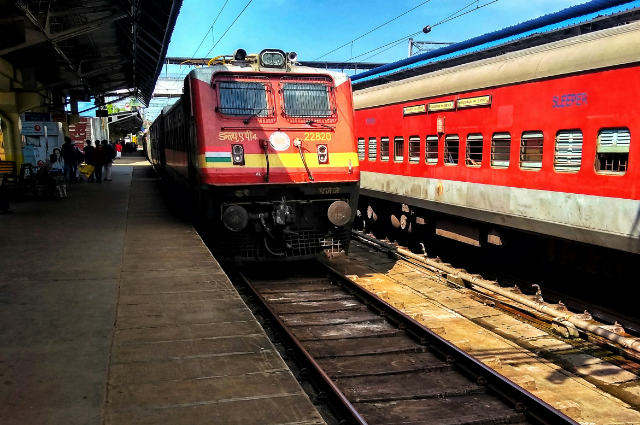
Photo by Adhirej J R Nair on Unsplash
Indian Railways (IR), overseen by the Ministry of Railways of the Government of India, stands as the backbone of India's transportation infrastructure. With a sprawling network encompassing a running track length of 104,647 km (65,025 mi) and a route length of 68,426 km (42,518 mi), of which 60,451 km (37,563 mi) is running on electric engines. It ranks as the world's fourth-largest national railway system by size. Alongside its massive reach, Indian Railways holds a huge socioeconomic impact, employing over 1.2 million people, making it the world's ninth-largest employer and India's second-largest employer. Traveling by train in India is a fantastic way to explore the country. India's extensive railway network covers vast distances, connecting remote villages to bustling cities.
Exploring India by train offers an unparalleled cultural experience that immerses travelers in the vibrant tapestry of the country's diverse communities and traditions. Train journeys provide ample opportunities to interact with locals from different regions of India. Whether sharing a compartment or chatting with fellow passengers during a meal, you'll engage in conversations that offer insights into local customs, languages, and ways of life.
One of the highlights of train travel in India is sampling regional cuisine available onboard or at stations. From savory snacks like samosas and pakoras to regional delicacies like biryani and dosa, each meal offers a culinary adventure reflecting the distinct flavors of the area you're passing through.
Train travel often coincides with festivals and celebrations across India. Depending on the time of year and route, you may witness colorful processions, lively music, and traditional performances at railway stations or from the train window, providing a firsthand experience of India's festive spirit.
Many trains in India connect major cultural and heritage destinations, allowing travelers to explore iconic landmarks such as palaces, temples, and historical monuments. Whether it's a journey to the Taj Mahal in Agra, the forts of Rajasthan, or the temples of Tamil Nadu, train travel offers convenient access to India's rich heritage.
India's railway network traverses a vast landscape encompassing mountains, plains, deserts, and coastal regions, each with its own unique cultural identity. As the train winds its way through diverse landscapes, you'll witness the architectural styles, attire, and customs that reflect the cultural diversity of the country.
Train travel provides a platform to observe and participate in local customs and rituals. From offering prayers at sacred sites visible from the train window to joining fellow passengers in traditional songs and dances, every moment on the train is an opportunity to engage with India's cultural heritage.
With over 1,600 languages and dialects spoken across India, train journeys offer a chance to learn and practice different linguistic nuances. Whether it's exchanging greetings in Hindi, Tamil, Bengali, or other regional languages, language becomes a bridge for cultural exchange during train travel.
Traveling by train in India is not just a mode of transportation but a cultural odyssey that exposes travelers to the richness and diversity of the country's traditions, cuisine, festivals, and people.
In addition to direct interactions and cultural experiences onboard, train travel in India offers unique glimpses into everyday life and local customs that may not be as apparent through other modes of transportation.
At many railway stations, passengers are welcomed by a bustling array of street vendors and hawkers selling snacks, drinks, handicrafts, and other local goods. This vibrant atmosphere provides a snapshot of the local economy and allows travelers to engage with small-scale entrepreneurs, often offering insights into regional specialities and traditional craftsmanship.
Overnight train journeys are common in India, particularly for longer routes. Sharing a compartment with fellow passengers for an extended period fosters a sense of camaraderie and community. Conversations often extend late into the night, offering opportunities to exchange stories, share meals, and even play games, creating lasting memories and connections.
On some trains, especially those catering to tourists or specific cultural routes, you may encounter live music performances, folk dance demonstrations, or storytelling sessions onboard. These cultural showcases provide a platform for local artists to showcase their talents while offering passengers an immersive cultural experience.
Many train routes in India pass through regions of religious significance, such as Varanasi, Haridwar, or Tirupati. During religious festivals or auspicious occasions, trains are often filled with pilgrims embarking on spiritual journeys. Witnessing their devotion, rituals, and chants onboard adds a profound dimension to the cultural experience, highlighting the integral role of religion in Indian society.
Some trains, particularly luxury and heritage trains, feature artistic decor and interiors inspired by regional themes and motifs. From intricately carved woodwork to colorful murals depicting local legends and folklore, the aesthetic elements onboard serve as visual reminders of India's diverse cultural heritage, adding to the immersive journey experience.
At major tourist destinations or heritage sites along train routes, local guides may offer guided tours to passengers, providing deeper insights into the historical, architectural, and cultural significance of these landmarks. These guided excursions enhance the cultural immersion by contextualizing the sights seen from the train window and offering a more comprehensive understanding of India's heritage.
By encompassing these additional elements, train travel in India becomes more than just a means of getting from one place to another - it becomes a holistic cultural expedition, revealing the essence of India's multifaceted identity and fostering connections between travelers and the diverse communities they encounter along the way.
